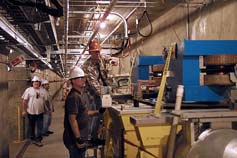
Handy Links
SLAC News Center
SLAC Today
- Subscribe
- Archives: Feb 2006-May 20, 2011
- Archives: May 23, 2011 and later
- Submit Feedback or Story Ideas
- About SLAC Today
SLAC News
Lab News
- Interactions
- Lightsources.org
- ILC NewsLine
- Int'l Science Grid This Week
- Fermilab Today
- Berkeley Lab News
- @brookhaven TODAY
- DOE Pulse
- CERN Courier
- DESY inForm
- US / LHC
SLAC Links
- Emergency
- Safety
- Policy Repository
- Site Entry Form

- Site Maps
- M & O Review
- Computing Status & Calendar
- SLAC Colloquium
- SLACspeak
- SLACspace
- SLAC Logo
- Café Menu
- Flea Market
- Web E-mail
- Marguerite Shuttle
- Discount Commuter Passes
-
Award Reporting Form
- SPIRES
- SciDoc
- Activity Groups
- Library
Stanford
Around the Bay
New Life for Linac
 After years of planning and hard work involving teams from every corner of the lab, SLAC's venerable linac has undergone the most radical set of alterations in its 40+ year career. Although a handful of minor tweaks remain, the effort to reconfigure the linac for the Linac Coherent Light Source (LCLS) is now just about complete.
After years of planning and hard work involving teams from every corner of the lab, SLAC's venerable linac has undergone the most radical set of alterations in its 40+ year career. Although a handful of minor tweaks remain, the effort to reconfigure the linac for the Linac Coherent Light Source (LCLS) is now just about complete.
"It's an exciting time and our first experiences have been very positive. We all look forward to the next level," said Paul Emma, head of the LCLS accelerator physics group. "The entire team is very happy with the results, but also glad for a break."
For decades, SLAC's two-mile long linac has enjoyed a resume of superlatives. Add to the list its new role as the injector and accelerator portion of the LCLS, the world's first hard-x-ray free electron laser. Commissioning of the injector portion began last April, and now, not only does the quality of the beam—emittance values, total charge, beam stability, etc.—meet or exceed design expectations, but the electron injector system is considered to be the brightest electron source in the world.
Although still fully capable of providing electron beams for high-energy physics experiments, the newly revved-up linac is now optimized to provide the ultra-fast, ultra-short pulses the LCLS will require. The newly reconfigured linac is specially optimized to create and accelerate the electron beams that will be used to generate the LCLS's powerful x-rays.
Converting the existing linac to an electron injector and accelerator for a free-electron laser was no small task, requiring the expertise of a host of SLAC working groups—including Controls, Alignment, Metrology, Environmental Safety and Health, Rigging, the Accelerator Division, Manufacturing and Purchasing, in addition to dozens of contractors.
"It was truly a site-wide operation," said Operations Manager Kathleen Ratcliffe, who oversaw the initial stages of this year's installation.
Many components, including beam diagnostic modules, magnets and accelerator sections had to be added, removed or shuffled to new locations.
"I called it the linac shuffle because we were moving stuff around and putting new stuff in—it was all spread out. There was a lot of movement," said Operations Manager Greg Diaz, who, along with Ratcliffe, oversaw the final stages of the project during the current shutdown.
Among the most complex of the recent installations was the second of two bunch compressors, or magnet chicanes, designed to shorten the bunch length of each electron pulse. The first such chicane, measuring about 18 feet long, was installed a year ago. The second chicane measures about 75 feet long and comprises enormous quadrupole magnets, each weighing 4,000 pounds, or about as much as a Ford Explorer. The scale of these components is necessary because the beam energy is higher by the time the pulses reach the second chicane. Between the two chicanes, the beam increases in energy from 250 Mev to 4.3 GeV, making the electrons harder to steer and requiring larger magnets.
Now that all of the LCLS-related hardware is in place along the linac, commissioning can continue in anticipation of first light in 2009. Emma says the challenge facing the team now will be to preserve the unprecedented beam brightness through to the Undulator Hall.
—Brad Plummer, SLAC Today, November 26, 2007
Above image: Crews working in the linac tunnel install two 4,000-pound magnets as part of the second bunch compressor for the LCLS.